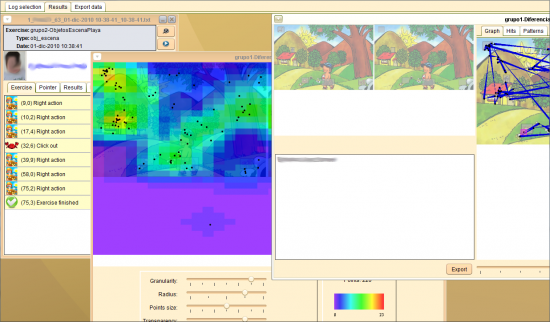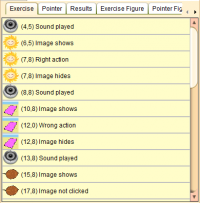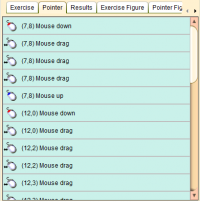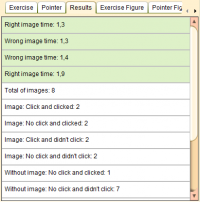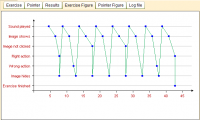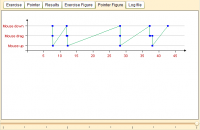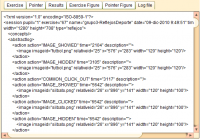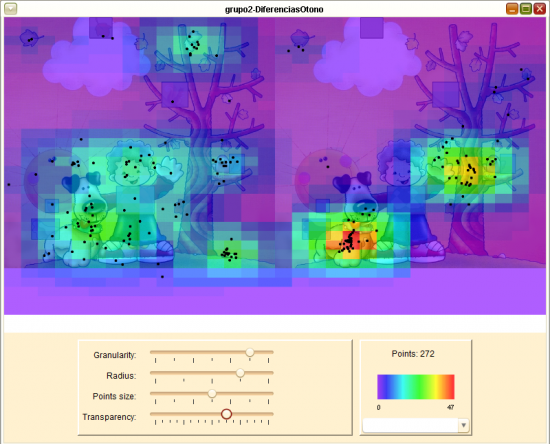Results Tab
From PatioWiki
m |
m (→Log File Tab) |
||
| (6 intermediate revisions not shown) | |||
| Line 1: | Line 1: | ||
[[File:Log_analysis_en.png|right|thumb|550px|Results tab]] | [[File:Log_analysis_en.png|right|thumb|550px|Results tab]] | ||
| - | The [[Results Tab]] | + | The [[Results Tab]] is a container of analysis windows, graphs and patterns. Each window can be minimized or closed, so that this tab behaves like a real desktop. |
__TOC__ | __TOC__ | ||
| Line 9: | Line 9: | ||
[[File:Log_header_results_en.png|right|thumb|250px|Header analysis window]] | [[File:Log_header_results_en.png|right|thumb|250px|Header analysis window]] | ||
| - | All analysis windows have a common header which contains the '''Exercise name''', | + | All analysis windows have a common header which contains the '''Exercise name''', its '''type''' and the date when it was performed. Below the header, the name and the picture of the pupil. In multi-user exercises, there are as many lines as pupils. |
| - | Besides, there are two buttons in the top right corner. The first one is for watching the | + | Besides, there are two buttons in the top right corner. The first one is for watching the video of children doing the exercise, if it is available and the multimedia player has been configured in the [[Configuration]] panel. The second button is used to replay the exercise with the [[Exercise Player]]. |
| - | Finally, there | + | Finally, there is series of tabs that are common to all analysis windows, but show different data depending on the module ([[APRENDO]], [[LEO]]...) and the exercise type. |
== Exercise Tab == | == Exercise Tab == | ||
| Line 21: | Line 21: | ||
This tab shows a list with the data from the ''abstractLog'' section of a [[Log]] file. | This tab shows a list with the data from the ''abstractLog'' section of a [[Log]] file. | ||
| - | The available info depends on the pupil's behaviour and the exercise type. Usually the ''abstractLog'' section contains data about high-level events happened | + | The available info depends on the pupil's behaviour and the exercise type. Usually the ''abstractLog'' section contains data about high-level events which happened when the pupil was doing the exercise. |
| - | Notice that each line of the list | + | Notice that in each line of the list there is an event icon followed by the event time mark in seconds and a description of the event. By double-clicking on a line, you can visualize the image events or hear sound events. |
| - | |||
== Pointer Tab == | == Pointer Tab == | ||
| Line 31: | Line 30: | ||
[[File:Log_pointer_en.png|right|thumb|200px|Pointer tab]] | [[File:Log_pointer_en.png|right|thumb|200px|Pointer tab]] | ||
| - | This tab shows a list with the data from the ''mouseLog'' section of | + | This tab shows a list with the data from the ''mouseLog'' section of the [[Logs]] files. |
The available info depends on the pupil's behaviour because in the ''mouseLog'' section all low level events are recorded during the exercise performing. | The available info depends on the pupil's behaviour because in the ''mouseLog'' section all low level events are recorded during the exercise performing. | ||
| Line 37: | Line 36: | ||
Note that each line of the list has an event icon followed by the event time mark in seconds and the description of it. | Note that each line of the list has an event icon followed by the event time mark in seconds and the description of it. | ||
| - | More info about ''mouseLog'' events is available in the [[ | + | More info about ''mouseLog'' events is available in the [[Logs]] topic. |
== Results Tab == | == Results Tab == | ||
| Line 45: | Line 44: | ||
In this tab an specific analysis of the exercise is made. As a result, data shown will be different depending on the type of exercise: | In this tab an specific analysis of the exercise is made. As a result, data shown will be different depending on the type of exercise: | ||
| - | === Results for | + | === Results for Sound-Image Matching exercises === |
| - | For '' | + | For '''Sound-Image Matching''' exercises the following data is obtained: |
* Specific Indicators | * Specific Indicators | ||
| - | ** IE-1.1: Image: Click and clicked | + | ** IE-1.1: Image: Click and clicked (Pupil had to click on the image and she did) |
| - | ** IE-1.2: Image: | + | ** IE-1.2: Image: No click and clicked (Pupil didn't have to click on the image but she did) |
| - | ** IE-1.3: Image: Click and | + | ** IE-1.3: Image: Click and didn't click (Pupil had to click on the image but she didn't) |
| - | ** IE-1.4: Image: | + | ** IE-1.4: Image: No click and didn't click (Pupil didn't have to click on the image and she didn't) |
| - | ** IE-1.5: Without image: | + | ** IE-1.5: Without image: No click and clicked (Pupil clicked when she shouldn't have) |
| - | ** IE-1.6: Without image: | + | ** IE-1.6: Without image: No click and didn't click (Pupil didn't click when she shouldn't have) |
* Common Indicators | * Common Indicators | ||
** IC-1.1: Total of images | ** IC-1.1: Total of images | ||
| - | ** IC-1.2: Average time of | + | ** IC-1.2: Average time of correct clicks |
| - | ** IC-1.3: Deviation time of | + | ** IC-1.3: Deviation time of correct clicks |
| - | ** IC-1.4: Average time of wrong | + | ** IC-1.4: Average time of wrong clicks |
| - | ** IC-1.5: Deviation time of wrong | + | ** IC-1.5: Deviation time of wrong clicks |
** IC-1.6: Exercise length | ** IC-1.6: Exercise length | ||
| - | === Results for | + | === Results for Differences exercises === |
| - | For '' | + | For '''Differences''' exercises the following data is obtained: |
* Specific Indicators | * Specific Indicators | ||
| Line 75: | Line 74: | ||
* Common Indicators | * Common Indicators | ||
** IC-2.1: Game ended | ** IC-2.1: Game ended | ||
| - | ** IC-2.2: Time of first | + | ** IC-2.2: Time of the first correct click |
| - | ** IC-2.3: Average time of | + | ** IC-2.3: Average time of correct clicks |
| - | ** IC-2.4: Deviation time of | + | ** IC-2.4: Deviation time of correct clicks |
** IC-2.5: Exercise length | ** IC-2.5: Exercise length | ||
| - | === Results for | + | === Results for Memory exercises === |
| - | For '' | + | For '''Memory''' exercises the following data is obtained: |
* Specific Indicators | * Specific Indicators | ||
** IE-3.1: Wrong clicks | ** IE-3.1: Wrong clicks | ||
| - | ** IE-3.2: | + | ** IE-3.2: Clicks on the background and before new images |
| - | ** IE-3.3: | + | ** IE-3.3: Clicks on the background and after new images |
** IE-3.4: Repeated wrong clicks | ** IE-3.4: Repeated wrong clicks | ||
* Common Indicators | * Common Indicators | ||
| - | ** IC-3.1: | + | ** IC-3.1: Correct clicks |
** IC-3.2: Game ended | ** IC-3.2: Game ended | ||
| - | ** IC-3.3: Time of first | + | ** IC-3.3: Time of the first correct image |
| - | ** IC-3.4: Average time between | + | ** IC-3.4: Average time between correct images |
| - | ** IC-3.5: Deviation time between | + | ** IC-3.5: Deviation time between correct images |
| - | ** IC-3.6: Time of first | + | ** IC-3.6: Time of first correct image |
** IC-3.7: Average time between wrong images | ** IC-3.7: Average time between wrong images | ||
** IC-3.8: Deviation time between wrong images | ** IC-3.8: Deviation time between wrong images | ||
** IC-3.9: Exercise length | ** IC-3.9: Exercise length | ||
| - | === Results for | + | === Results for Objects-Scenes exercises === |
| - | For '' | + | For '''Objects-Scenes''' exercises the following data is obtained: |
* Specific Indicators | * Specific Indicators | ||
| - | ** IE-4.1: | + | ** IE-4.1: Clicks on instructions |
** IE-4.2: Wrong clicks | ** IE-4.2: Wrong clicks | ||
* Common Indicators | * Common Indicators | ||
| - | ** IC-4.1: | + | ** IC-4.1: Correct clicks |
| - | ** IC-4.2: | + | ** IC-4.2: Time of the first correct click |
| - | ** IC-4.3: Time between | + | ** IC-4.3: Time between correct clicks |
| - | ** IC-4.4: Average time between | + | ** IC-4.4: Average time between correct clicks |
| - | ** IC-4.5: Deviation time between | + | ** IC-4.5: Deviation time between correct clicks |
| - | ** IC-4.6: | + | ** IC-4.6: Time of the first click on instruction |
** IC-4.7: Average time between clicks over instructions | ** IC-4.7: Average time between clicks over instructions | ||
** IC-4.8: Deviation time between clicks over instructions | ** IC-4.8: Deviation time between clicks over instructions | ||
| - | ** IC-4.9: | + | ** IC-4.9: Time of the first wrong click |
** IC-4.10: Average time between wrong clicks | ** IC-4.10: Average time between wrong clicks | ||
| - | ** IC-4.11: Deviation time between wrong clicks | + | ** IC-4.11: Deviation time between wrong clicks |
| - | === Results for | + | === Results for Reaction Time exercises === |
| - | For '' | + | For '''Reaction Time''' exercises the following data is obtained: |
* Specific Indicators | * Specific Indicators | ||
** IE-5.1: Total of images | ** IE-5.1: Total of images | ||
* Common Indicators | * Common Indicators | ||
| - | ** IC-5.1: | + | ** IC-5.1: Correct clicks |
| - | ** IC-5.2: | + | ** IC-5.2: Clicks out of images |
| - | ** IC-5.3: | + | ** IC-5.3: Clicks when no image is shown |
| - | ** IC-5.4: Average time of | + | ** IC-5.4: Average time of correct clicks |
| - | ** IC-5.5: Deviation time of | + | ** IC-5.5: Deviation time of correct clicks |
| - | ** IC-5.6: Average time of | + | ** IC-5.6: Average time of clicks out of image |
| - | ** IC-5.7: Deviation time of | + | ** IC-5.7: Deviation time of clicks out of images |
| - | ** IC-5.8: Average time of no image | + | ** IC-5.8: Average time of clicks when no image is shown |
| - | ** IC-5.9: Deviation time of no image | + | ** IC-5.9: Deviation time of clicks when no image is shown |
| - | ** IC-5.10: Average distance of | + | ** IC-5.10: Average distance of clicks out of image |
| - | ** IC-5.11: Deviation distance of | + | ** IC-5.11: Deviation distance of clicks out of image |
** IC-5.12: Exercise length | ** IC-5.12: Exercise length | ||
| - | === Results for | + | === Results for Choose the odd one exercises === |
| - | For '' | + | For '''Choose the odd one''' exercises the following data is obtained: |
* Specific Indicators | * Specific Indicators | ||
| - | ** IE-6.1: Consecutive | + | ** IE-6.1: Consecutive correct clicks |
| - | ** IE-6.2: Repeated | + | ** IE-6.2: Repeated correct clicks |
* Common Indicators | * Common Indicators | ||
| - | ** IC-6.1: | + | ** IC-6.1: Correct clicks |
| - | ** IC-6.2: | + | ** IC-6.2: Clicks out of image |
** IC-6.3: Wrong clicks | ** IC-6.3: Wrong clicks | ||
| - | ** IC-6.4: | + | ** IC-6.4: Time of the first click |
| - | ** IC-6.5: | + | ** IC-6.5: Time of the first correct click |
| - | ** IC-6.6: Average time between | + | ** IC-6.6: Average time between correct clicks |
| - | ** IC-6.7: Deviation time between | + | ** IC-6.7: Deviation time between correct clicks |
| - | ** IC-6.8: | + | ** IC-6.8: Time of the first wrong click |
** IC-6.9: Average time between wrong clicks | ** IC-6.9: Average time between wrong clicks | ||
** IC-6.10: Deviation time between wrong clicks | ** IC-6.10: Deviation time between wrong clicks | ||
| - | ** IC-6.11: | + | ** IC-6.11: Time of the first click out of image |
| - | ** IC-6.12: Average time between | + | ** IC-6.12: Average time between clicks out of image |
| - | ** IC-6.13: Deviation time between | + | ** IC-6.13: Deviation time between clicks out of image |
| - | ** IC-6.14: Average time between | + | ** IC-6.14: Average time between correct repeated clicks |
| - | ** IC-6.15: Deviation time between | + | ** IC-6.15: Deviation time between correct repeated clicks |
** IC-6.16: Exercise length | ** IC-6.16: Exercise length | ||
| - | === Results for | + | === Results for Series === |
| - | For '' | + | For '''Series''' exercises the following data is obtained: |
| - | * IC: Total | + | * IC: Total correct images |
* IE: Total wrong images | * IE: Total wrong images | ||
* MI: Total moved images | * MI: Total moved images | ||
| - | * MTIC: Average time of | + | * MTIC: Average time of correct images |
| - | * DTIC: Deviation time of | + | * DTIC: Deviation time of correct images |
| - | * MTIE: Average time of wrong | + | * MTIE: Average time of wrong images |
| - | * DTIE: Deviation time of wrong | + | * DTIE: Deviation time of wrong images |
| - | * MTIFC: Average time | + | * MTIFC: Average time of moved images |
| - | * DTIFC: Deviation time of | + | * DTIFC: Deviation time of moved images |
* DE: Exercise length | * DE: Exercise length | ||
| - | === Results for | + | === Results for Series Multiuser === |
| - | For '' | + | For '''Series Multiuser''' exercises the following data is obtained: |
* Single Indicators | * Single Indicators | ||
| - | ** I.1: Total | + | ** I.1: Total correct images |
** I.2: Total wrong images | ** I.2: Total wrong images | ||
** I.3: Total moved images | ** I.3: Total moved images | ||
| - | ** I.4: | + | ** I.4: Turns taken |
| - | ** I.5: | + | ** I.5: Turns transferred |
| - | ** I.6: | + | ** I.6: Illegitimate turns |
** I.7: Score | ** I.7: Score | ||
* Group Indicators | * Group Indicators | ||
** G.1: Exceeded turns | ** G.1: Exceeded turns | ||
** G.2: Number of players | ** G.2: Number of players | ||
| - | ** G.3: Placed | + | ** G.3: Placed images |
** G.4: Group score | ** G.4: Group score | ||
** G.5: Exercise length | ** G.5: Exercise length | ||
| - | === Results for | + | === Results for Writing === |
| - | For '' | + | For '''Writing''' exercises the following data is obtained: |
| - | * Ex1: Total | + | * Ex1: Total of reproduces videos |
* Ex2: Exercise length | * Ex2: Exercise length | ||
| - | === Results for | + | === Results for Letter Cloud === |
| - | For '' | + | For '''Letter Cloud''' exercises the following data is obtained: |
* Ex1: Total token hits | * Ex1: Total token hits | ||
| Line 220: | Line 219: | ||
[[file:Log_exercise_graph_en.png|right|thumb|200px|Exercise Graph tab]] | [[file:Log_exercise_graph_en.png|right|thumb|200px|Exercise Graph tab]] | ||
| - | This tab contains a graph produced with the data from the ''abstractLog'' section of | + | This tab contains a graph produced with the data from the ''abstractLog'' section of the [[Logs]] files. The Y axis represents the exercise events, and the X axis is used for the exercise time; its length depends on the amount of time the user spent on doing the exercise. |
| - | In the same way as in the '''Exercise Tab''' the data available will change depending on the pupil behaviour and the type of exercise. | + | In the same way as in the '''Exercise Tab''', the data available will change depending on the pupil's behaviour and the type of exercise. |
| - | Note that the goal of this analysis is | + | Note that the goal of this analysis is building a temporal diagram showing the pupil's actions in order to draw visual inference from her behaviour and the order she followed to do the exercise. |
| - | |||
== Pointer Figure Tab == | == Pointer Figure Tab == | ||
| Line 232: | Line 230: | ||
[[file:Log_pointer_graph_en.png|right|thumb|200px|Pointer Graph tab]] | [[file:Log_pointer_graph_en.png|right|thumb|200px|Pointer Graph tab]] | ||
| - | This tab contains a graph produced with the data from the ''mouseLog'' section of | + | This tab contains a graph produced with the data from the ''mouseLog'' section of the [[Logs]] files. The Y axis represents the pointer events, and the X axis is used for the exercise time. Like in the previous tab, the length of the time axis depends on the time pupil spent doing the exercise. |
| - | Note that this figure could be hard to read when the pupil behaves erratically without | + | Note that this figure could be hard to read when the pupil behaves erratically without achieving the goal of the exercise. |
| - | More info about ''mouseLog'' events is available in the [[ | + | More info about ''mouseLog'' events is available in the [[Logs]] topic. |
== Extra Tab == | == Extra Tab == | ||
| Line 242: | Line 240: | ||
[[File:Log_extra_analysis_en.png|right|thumb|200px|Extra tab]] | [[File:Log_extra_analysis_en.png|right|thumb|200px|Extra tab]] | ||
| - | This tab is only visible in the analysis of exercises of '' | + | This tab is only visible in the analysis of exercises of the '''Differences''' and '''Objects-Scenes''' types from the [[APRENDO]] module and for exercises of the '''Writing''' type from the [[Leo]] module. It contains a graph formed by dots which represent the clicks made by the pupil. The dots are connected by arrows in order to show the sequence the pupil has followed. |
| - | Using a | + | Using a slider you can go forward or backward in the sequence of dots. There is another slider for changing the level of transparency of the background image of the exercise. As a result, all dots can be seen clearly. |
| - | There is | + | There is a different manner of replaying exactly the way the pupil completed an exercise, using the [[Exercise Player]]. |
== Log File Tab == | == Log File Tab == | ||
| Line 252: | Line 250: | ||
[[File:Log_log_file_en.png|right|thumb|200px|Log file]] | [[File:Log_log_file_en.png|right|thumb|200px|Log file]] | ||
| - | In this tab, the last one, you can see the | + | In this tab, the last one, you can see the log file coded in [http://en.wikipedia.org/wiki/XML XML], in case you want to check the analysis made at a very low level. |
= Graphs = | = Graphs = | ||
| - | This graphical analysis only can be performed in exercises of '' | + | This graphical analysis only can be performed in exercises of '''Differences''' and '''Objects-Scenes''' types because only they involve searching for objects in an image. This exercise is ideal to analyse the search points that pupils have clicked with the pointing device. |
| - | + | Since the graph shows the search points made in the exercise, you can combine many exercises of the same type and the same window dimensions. Then, the analysis adds a layer on the top of the exercise, drawing with different colours the point density for each delimited area. This representation can be modified changing the graph parameters with the sliders of the bottom panel: | |
; Granularity | ; Granularity | ||
| - | : Changes the | + | : Changes the dimensions of the array cell. |
; Radius | ; Radius | ||
| - | : Controls the influence of the neighbour cells on the value of each single | + | : Controls the influence of the neighbour cells on the value of each single array cell. |
; Points size | ; Points size | ||
| - | : Modifies the | + | : Modifies the size of points. |
; Transparency | ; Transparency | ||
: Controls the transparency level of the density layer, so background image can be gradually unveiled. | : Controls the transparency level of the density layer, so background image can be gradually unveiled. | ||
| - | Besides, a scale is provided in order to assign to each colour of the graph the number of points that it represents. Above the scale, you can read the total number of points in the graph and | + | Besides, a scale is provided in order to assign to each colour of the graph the number of points that it represents. Above the scale, you can read the total number of points in the graph and at the bottom of the panel you can select the name of the pupil whose points will be highlighted. This combo box is initially blank and it is useful only in graphs showing points of more than just one pupil. |
[[File:Log_graph_en.png|center|thumb|550px|Points graph]] | [[File:Log_graph_en.png|center|thumb|550px|Points graph]] | ||
| Line 275: | Line 273: | ||
= Patterns = | = Patterns = | ||
| - | The exercises of '' | + | The exercises of '''Differences''' and '''Objects-Scenes''' types have search points that can be interpreted like patterns. This analysis calculates the '''Search''' and '''Hits''' patterns and allows us to see the combined directional graph for many pupils, all in the same window. |
| - | This window has three | + | This window has three parts. A directed graph in the top left panel where you can view the search point of the selected pupil; a list in the bottom left panel where you can select the pupil to be highlighted; and a panel on the right that contains three tabs: |
; Graph | ; Graph | ||
| - | : Contains all | + | : Contains all directed graphs from the analysed logs in which the selected pupil from the list will be highlighted. |
; Hits | ; Hits | ||
: Contains all hit patterns calculated using the analysed logs. | : Contains all hit patterns calculated using the analysed logs. | ||
| Line 286: | Line 284: | ||
: Contains all click patterns calculated using the analysed logs. | : Contains all click patterns calculated using the analysed logs. | ||
| - | Finally, you can export in a [http:// | + | Finally, you can export in a [http://en.wikipedia.org/wiki/Comma-separated_values CSV] file all the patterns from the analysis using the '''Export''' button. |
[[File:Log_patterns_en.png|center|thumb|550px|Pattern Analysis]] | [[File:Log_patterns_en.png|center|thumb|550px|Pattern Analysis]] | ||
| - | [[Category: | + | [[Category:Main]] |
| + | [[Category:User and sessions management]] | ||
| + | [[Category:View results]] | ||
[[es: Pestaña Resultados]] | [[es: Pestaña Resultados]] | ||
Current revision as of 06:50, 3 May 2013
The Results Tab is a container of analysis windows, graphs and patterns. Each window can be minimized or closed, so that this tab behaves like a real desktop.
Analysis
All analysis windows have a common header which contains the Exercise name, its type and the date when it was performed. Below the header, the name and the picture of the pupil. In multi-user exercises, there are as many lines as pupils.
Besides, there are two buttons in the top right corner. The first one is for watching the video of children doing the exercise, if it is available and the multimedia player has been configured in the Configuration panel. The second button is used to replay the exercise with the Exercise Player.
Finally, there is series of tabs that are common to all analysis windows, but show different data depending on the module (APRENDO, LEO...) and the exercise type.
Exercise Tab
This tab shows a list with the data from the abstractLog section of a Log file.
The available info depends on the pupil's behaviour and the exercise type. Usually the abstractLog section contains data about high-level events which happened when the pupil was doing the exercise.
Notice that in each line of the list there is an event icon followed by the event time mark in seconds and a description of the event. By double-clicking on a line, you can visualize the image events or hear sound events.
Pointer Tab
This tab shows a list with the data from the mouseLog section of the Logs files.
The available info depends on the pupil's behaviour because in the mouseLog section all low level events are recorded during the exercise performing.
Note that each line of the list has an event icon followed by the event time mark in seconds and the description of it.
More info about mouseLog events is available in the Logs topic.
Results Tab
In this tab an specific analysis of the exercise is made. As a result, data shown will be different depending on the type of exercise:
Results for Sound-Image Matching exercises
For Sound-Image Matching exercises the following data is obtained:
- Specific Indicators
- IE-1.1: Image: Click and clicked (Pupil had to click on the image and she did)
- IE-1.2: Image: No click and clicked (Pupil didn't have to click on the image but she did)
- IE-1.3: Image: Click and didn't click (Pupil had to click on the image but she didn't)
- IE-1.4: Image: No click and didn't click (Pupil didn't have to click on the image and she didn't)
- IE-1.5: Without image: No click and clicked (Pupil clicked when she shouldn't have)
- IE-1.6: Without image: No click and didn't click (Pupil didn't click when she shouldn't have)
- Common Indicators
- IC-1.1: Total of images
- IC-1.2: Average time of correct clicks
- IC-1.3: Deviation time of correct clicks
- IC-1.4: Average time of wrong clicks
- IC-1.5: Deviation time of wrong clicks
- IC-1.6: Exercise length
Results for Differences exercises
For Differences exercises the following data is obtained:
- Specific Indicators
- IE-2.1: Hits on differences
- IE-2.2: Clicks out of image
- IE-2.3: Clicks on the left image
- IE-2.4: Clicks on the right image
- Common Indicators
- IC-2.1: Game ended
- IC-2.2: Time of the first correct click
- IC-2.3: Average time of correct clicks
- IC-2.4: Deviation time of correct clicks
- IC-2.5: Exercise length
Results for Memory exercises
For Memory exercises the following data is obtained:
- Specific Indicators
- IE-3.1: Wrong clicks
- IE-3.2: Clicks on the background and before new images
- IE-3.3: Clicks on the background and after new images
- IE-3.4: Repeated wrong clicks
- Common Indicators
- IC-3.1: Correct clicks
- IC-3.2: Game ended
- IC-3.3: Time of the first correct image
- IC-3.4: Average time between correct images
- IC-3.5: Deviation time between correct images
- IC-3.6: Time of first correct image
- IC-3.7: Average time between wrong images
- IC-3.8: Deviation time between wrong images
- IC-3.9: Exercise length
Results for Objects-Scenes exercises
For Objects-Scenes exercises the following data is obtained:
- Specific Indicators
- IE-4.1: Clicks on instructions
- IE-4.2: Wrong clicks
- Common Indicators
- IC-4.1: Correct clicks
- IC-4.2: Time of the first correct click
- IC-4.3: Time between correct clicks
- IC-4.4: Average time between correct clicks
- IC-4.5: Deviation time between correct clicks
- IC-4.6: Time of the first click on instruction
- IC-4.7: Average time between clicks over instructions
- IC-4.8: Deviation time between clicks over instructions
- IC-4.9: Time of the first wrong click
- IC-4.10: Average time between wrong clicks
- IC-4.11: Deviation time between wrong clicks
Results for Reaction Time exercises
For Reaction Time exercises the following data is obtained:
- Specific Indicators
- IE-5.1: Total of images
- Common Indicators
- IC-5.1: Correct clicks
- IC-5.2: Clicks out of images
- IC-5.3: Clicks when no image is shown
- IC-5.4: Average time of correct clicks
- IC-5.5: Deviation time of correct clicks
- IC-5.6: Average time of clicks out of image
- IC-5.7: Deviation time of clicks out of images
- IC-5.8: Average time of clicks when no image is shown
- IC-5.9: Deviation time of clicks when no image is shown
- IC-5.10: Average distance of clicks out of image
- IC-5.11: Deviation distance of clicks out of image
- IC-5.12: Exercise length
Results for Choose the odd one exercises
For Choose the odd one exercises the following data is obtained:
- Specific Indicators
- IE-6.1: Consecutive correct clicks
- IE-6.2: Repeated correct clicks
- Common Indicators
- IC-6.1: Correct clicks
- IC-6.2: Clicks out of image
- IC-6.3: Wrong clicks
- IC-6.4: Time of the first click
- IC-6.5: Time of the first correct click
- IC-6.6: Average time between correct clicks
- IC-6.7: Deviation time between correct clicks
- IC-6.8: Time of the first wrong click
- IC-6.9: Average time between wrong clicks
- IC-6.10: Deviation time between wrong clicks
- IC-6.11: Time of the first click out of image
- IC-6.12: Average time between clicks out of image
- IC-6.13: Deviation time between clicks out of image
- IC-6.14: Average time between correct repeated clicks
- IC-6.15: Deviation time between correct repeated clicks
- IC-6.16: Exercise length
Results for Series
For Series exercises the following data is obtained:
- IC: Total correct images
- IE: Total wrong images
- MI: Total moved images
- MTIC: Average time of correct images
- DTIC: Deviation time of correct images
- MTIE: Average time of wrong images
- DTIE: Deviation time of wrong images
- MTIFC: Average time of moved images
- DTIFC: Deviation time of moved images
- DE: Exercise length
Results for Series Multiuser
For Series Multiuser exercises the following data is obtained:
- Single Indicators
- I.1: Total correct images
- I.2: Total wrong images
- I.3: Total moved images
- I.4: Turns taken
- I.5: Turns transferred
- I.6: Illegitimate turns
- I.7: Score
- Group Indicators
- G.1: Exceeded turns
- G.2: Number of players
- G.3: Placed images
- G.4: Group score
- G.5: Exercise length
Results for Writing
For Writing exercises the following data is obtained:
- Ex1: Total of reproduces videos
- Ex2: Exercise length
Results for Letter Cloud
For Letter Cloud exercises the following data is obtained:
- Ex1: Total token hits
- Ex2: Total token misses
- Ex3: Total identification hits
- Ex4: Total identification misses
- Ex5: Exercise length
Exercise Figure Tab
This tab contains a graph produced with the data from the abstractLog section of the Logs files. The Y axis represents the exercise events, and the X axis is used for the exercise time; its length depends on the amount of time the user spent on doing the exercise.
In the same way as in the Exercise Tab, the data available will change depending on the pupil's behaviour and the type of exercise.
Note that the goal of this analysis is building a temporal diagram showing the pupil's actions in order to draw visual inference from her behaviour and the order she followed to do the exercise.
Pointer Figure Tab
This tab contains a graph produced with the data from the mouseLog section of the Logs files. The Y axis represents the pointer events, and the X axis is used for the exercise time. Like in the previous tab, the length of the time axis depends on the time pupil spent doing the exercise.
Note that this figure could be hard to read when the pupil behaves erratically without achieving the goal of the exercise.
More info about mouseLog events is available in the Logs topic.
Extra Tab
This tab is only visible in the analysis of exercises of the Differences and Objects-Scenes types from the APRENDO module and for exercises of the Writing type from the Leo module. It contains a graph formed by dots which represent the clicks made by the pupil. The dots are connected by arrows in order to show the sequence the pupil has followed.
Using a slider you can go forward or backward in the sequence of dots. There is another slider for changing the level of transparency of the background image of the exercise. As a result, all dots can be seen clearly.
There is a different manner of replaying exactly the way the pupil completed an exercise, using the Exercise Player.
Log File Tab
In this tab, the last one, you can see the log file coded in XML, in case you want to check the analysis made at a very low level.
Graphs
This graphical analysis only can be performed in exercises of Differences and Objects-Scenes types because only they involve searching for objects in an image. This exercise is ideal to analyse the search points that pupils have clicked with the pointing device.
Since the graph shows the search points made in the exercise, you can combine many exercises of the same type and the same window dimensions. Then, the analysis adds a layer on the top of the exercise, drawing with different colours the point density for each delimited area. This representation can be modified changing the graph parameters with the sliders of the bottom panel:
- Granularity
- Changes the dimensions of the array cell.
- Radius
- Controls the influence of the neighbour cells on the value of each single array cell.
- Points size
- Modifies the size of points.
- Transparency
- Controls the transparency level of the density layer, so background image can be gradually unveiled.
Besides, a scale is provided in order to assign to each colour of the graph the number of points that it represents. Above the scale, you can read the total number of points in the graph and at the bottom of the panel you can select the name of the pupil whose points will be highlighted. This combo box is initially blank and it is useful only in graphs showing points of more than just one pupil.
Patterns
The exercises of Differences and Objects-Scenes types have search points that can be interpreted like patterns. This analysis calculates the Search and Hits patterns and allows us to see the combined directional graph for many pupils, all in the same window.
This window has three parts. A directed graph in the top left panel where you can view the search point of the selected pupil; a list in the bottom left panel where you can select the pupil to be highlighted; and a panel on the right that contains three tabs:
- Graph
- Contains all directed graphs from the analysed logs in which the selected pupil from the list will be highlighted.
- Hits
- Contains all hit patterns calculated using the analysed logs.
- Patterns
- Contains all click patterns calculated using the analysed logs.
Finally, you can export in a CSV file all the patterns from the analysis using the Export button.
